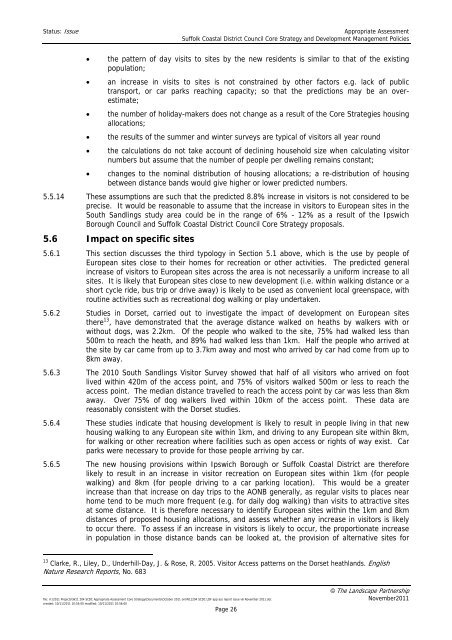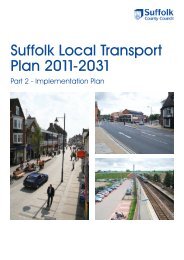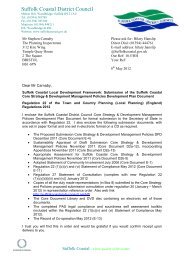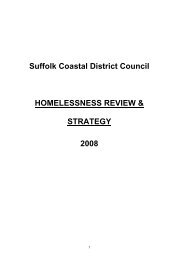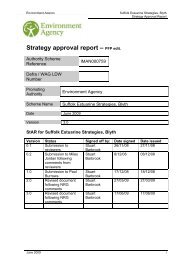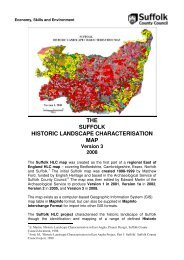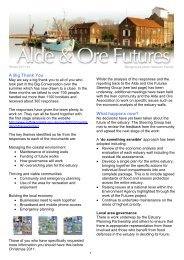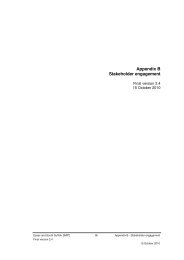natura 2000 standard data form - Suffolk Coastal District Council
natura 2000 standard data form - Suffolk Coastal District Council
natura 2000 standard data form - Suffolk Coastal District Council
Create successful ePaper yourself
Turn your PDF publications into a flip-book with our unique Google optimized e-Paper software.
Status: Issue Appropriate Assessment<br />
<strong>Suffolk</strong> <strong>Coastal</strong> <strong>District</strong> <strong>Council</strong> Core Strategy and Development Management Policies<br />
• the pattern of day visits to sites by the new residents is similar to that of the existing<br />
population;<br />
• an increase in visits to sites is not constrained by other factors e.g. lack of public<br />
transport, or car parks reaching capacity; so that the predictions may be an overestimate;<br />
• the number of holiday-makers does not change as a result of the Core Strategies housing<br />
allocations;<br />
• the results of the summer and winter surveys are typical of visitors all year round<br />
• the calculations do not take account of declining household size when calculating visitor<br />
numbers but assume that the number of people per dwelling remains constant;<br />
• changes to the nominal distribution of housing allocations; a re-distribution of housing<br />
between distance bands would give higher or lower predicted numbers.<br />
5.5.14 These assumptions are such that the predicted 8.8% increase in visitors is not considered to be<br />
precise. It would be reasonable to assume that the increase in visitors to European sites in the<br />
South Sandlings study area could be in the range of 6% - 12% as a result of the Ipswich<br />
Borough <strong>Council</strong> and <strong>Suffolk</strong> <strong>Coastal</strong> <strong>District</strong> <strong>Council</strong> Core Strategy proposals.<br />
5.6 Impact on specific sites<br />
5.6.1 This section discusses the third typology in Section 5.1 above, which is the use by people of<br />
European sites close to their homes for recreation or other activities. The predicted general<br />
increase of visitors to European sites across the area is not necessarily a uni<strong>form</strong> increase to all<br />
sites. It is likely that European sites close to new development (i.e. within walking distance or a<br />
short cycle ride, bus trip or drive away) is likely to be used as convenient local greenspace, with<br />
routine activities such as recreational dog walking or play undertaken.<br />
5.6.2 Studies in Dorset, carried out to investigate the impact of development on European sites<br />
there 13 , have demonstrated that the average distance walked on heaths by walkers with or<br />
without dogs, was 2.2km. Of the people who walked to the site, 75% had walked less than<br />
500m to reach the heath, and 89% had walked less than 1km. Half the people who arrived at<br />
the site by car came from up to 3.7km away and most who arrived by car had come from up to<br />
8km away.<br />
5.6.3 The 2010 South Sandlings Visitor Survey showed that half of all visitors who arrived on foot<br />
lived within 420m of the access point, and 75% of visitors walked 500m or less to reach the<br />
access point. The median distance travelled to reach the access point by car was less than 8km<br />
away. Over 75% of dog walkers lived within 10km of the access point. These <strong>data</strong> are<br />
reasonably consistent with the Dorset studies.<br />
5.6.4 These studies indicate that housing development is likely to result in people living in that new<br />
housing walking to any European site within 1km, and driving to any European site within 8km,<br />
for walking or other recreation where facilities such as open access or rights of way exist. Car<br />
parks were necessary to provide for those people arriving by car.<br />
5.6.5 The new housing provisions within Ipswich Borough or <strong>Suffolk</strong> <strong>Coastal</strong> <strong>District</strong> are therefore<br />
likely to result in an increase in visitor recreation on European sites within 1km (for people<br />
walking) and 8km (for people driving to a car parking location). This would be a greater<br />
increase than that increase on day trips to the AONB generally, as regular visits to places near<br />
home tend to be much more frequent (e.g. for daily dog walking) than visits to attractive sites<br />
at some distance. It is therefore necessary to identify European sites within the 1km and 8km<br />
distances of proposed housing allocations, and assess whether any increase in visitors is likely<br />
to occur there. To assess if an increase in visitors is likely to occur, the proportionate increase<br />
in population in those distance bands can be looked at, the provision of alternative sites for<br />
13 Clarke, R., Liley, D., Underhill-Day, J. & Rose, R. 2005. Visitor Access patterns on the Dorset heathlands. English<br />
Nature Research Reports, No. 683<br />
© The Landscape Partnership<br />
file: V:\2011 Projects\W11 204 SCDC Appropriate Assessment Core Strategy\Documents\October 2011 on\W11204 SCDC LDF app ass report issue v6 November 2011.doc November2011<br />
created: 10/11/2011 10:55:00 modified: 10/11/2011 10:56:00<br />
Page 26


